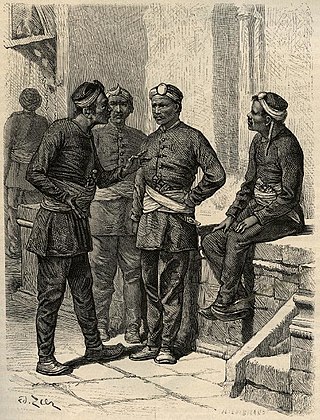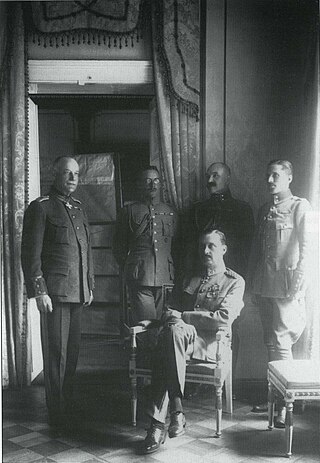This article needs additional citations for verification .(March 2013) |
Jemadar or jamadar is a title used for various military and other officials in the Indian subcontinent.
This article needs additional citations for verification .(March 2013) |
Jemadar or jamadar is a title used for various military and other officials in the Indian subcontinent.
The word stems from Urdu (جمعدار), which derives through Persian jam'dar from Arabic jamā‘a(t) 'muster' + Persian -dār 'holder'.
A jemadar was originally an armed official of a zamindar (feudal lord) in India who, like a military general, and along with Mridhas, was in charge of fighting and conducting warfare, mostly against the rebellious peasants and common people who lived on the lord's land. [1] Also, this rank was used among the thuggees as well, usually the gang leader.
Later, it became a rank used in the British Indian Army, where it was the lowest rank for a Viceroy's commissioned officer. Jemadars either commanded platoons or troops themselves or assisted their British commander. They also filled regimental positions such as assistant quartermaster (jemadar quartermaster) or assistant adjutant (jemadar adjutant).
The rank remained in use in the Indian Army until 1965 as the lowest rank of junior commissioned officer. The rank of jemadar was later renamed in both the Indian Army and the Pakistan Army as naib subedar in infantry units, and naib risaldar in cavalry and armoured corps units. Jemadar remains a warrant officer rank in the Nepal Army.

A non-commissioned officer (NCO) is a military officer who does not hold a commission. Non-commissioned officers usually earn their position of authority by promotion through the enlisted ranks. In contrast, commissioned officers usually enter directly from a military academy, officer training corps (OTC) or reserve officer training corps (ROTC), or officer candidate school (OCS) or officer training school (OTS), after receiving a post-secondary degree.

The Gurkhas or Gorkhas, with the endonym Gorkhali, are soldiers native to the Indian subcontinent, chiefly residing within Nepal and some parts of North India.
Sergeant (Sgt) is a rank in use by the armed forces of many countries. It is also a police rank in some police services. The alternative spelling, serjeant, is used in The Rifles and other units that draw their heritage from the British light infantry. Its origin is the Latin serviens, 'one who serves', through the Old French term serjant.

Adjutant is a military appointment given to an officer who assists the commanding officer with unit administration, mostly the management of human resources in an army unit. The term adjudant is used in French-speaking armed forces as a non-commissioned officer rank similar to a staff sergeant or warrant officer but is not equivalent to the role or appointment of an adjutant.

An adjutant general is a military chief administrative officer.
Havildar or havaldar is a rank in the Indian and Pakistani armies, equivalent to sergeant. It is not used in cavalry units, where the equivalent is daffadar.

Quartermaster is a military term, the meaning of which depends on the country and service. In land armies, a quartermaster is an officer who supervises logistics and requisitions, manages stores or barracks, and distributes supplies and provisions. In many navies, a quartermaster is a seaman or petty officer with responsibility for navigation and operation of the helm of a ship.

A military staff or general staff is a group of officers, enlisted and civilian staff who serve the commander of a division or other large military unit in their command and control role through planning, analysis, and information gathering, as well as by relaying, coordinating, and supervising the execution of their plans and orders, especially in case of multiple simultaneous and rapidly changing complex operations. They are organised into functional groups such as administration, logistics, operations, intelligence, training, etc. They provide multi-directional flow of information between a commanding officer, subordinate military units and other stakeholders. A centralised general staff results in tighter top-down control but requires larger staff at headquarters (HQ) and reduces accuracy of orientation of field operations, whereas a decentralised general staff results in enhanced situational focus, personal initiative, speed of localised action, OODA loop, and improved accuracy of orientation.
Risaldar, meaning the commander of a risala or risalah in Persian, is a mid-level rank in cavalry and armoured units of the Indian and Pakistan Army. In other arms, such as the infantry, the equivalent rank is subedar.
Subedar is a military rank in the militaries of South Asia roughly equivalent to that of a warrant officer. Historically classes in the British Indian Army as a Viceroy's commissioned officer, the rank was retained in the Indian Army and Pakistan Army after independence. The rank of subedar is classed as a junior commissioned officer rank in India and Pakistan.
A viceroy's commissioned officer (VCO) was a senior Indian member of the British Indian Army. VCOs were senior in rank to warrant officers in the British Army, and held a commission issued by the viceroy. Also known as "Indian officers" or "native officers", they had authority only over Indian troops and were subordinate to all British King's commissioned officers, Indian Commissioned Officers (ICO) and King's commissioned Indian officers (KCIO).
Ressaidar was a Viceroy's commissioned officer's (VCO) rank in the British Indian Army. Ressaidar denoted a junior commander of a risala or risalah in Persian.
The Indian Army, the land component of the Indian Armed Forces, follows a certain hierarchy of rank designations and insignia derived from the erstwhile British Indian Army (BIA).

General Sir Beauchamp Duff, was a Scottish officer with a distinguished career in the British Indian Army. He served as Commander-in-Chief of India during the First World War. His role in the disastrous expedition to Mesopotamia was criticised, helping to end a long career.

Lieutenant General Sagat Singh, PVSM was a General Officer in the Indian Army, notable for his participation in the liberation of Goa and later in Indo-Pakistani war of 1971. He held many commands and staff appointments throughout his career.

The Silladar Cavalry, also known as the Risalah, was a term describing a mounted force of irregular cavalry regiments at times in Indian history. Silladar means “bearer of arms” in Persian and was given to native cavalrymen (sowars) of irregular regiments. A recruit or "Khudaspa" was supposed to provide his own mount and weapons as well as stabling attendant, forage, tent and clothing. It was opposed to having them provided for them by any local or central group or command. They were recruited from local dominant landowning clans, who were cultivators and who traditionally owned weapons and provided military service to local feudal chiefs. The irregular cavalry regiments were almost entirely composed of Muslims, because "the Hindoos are not, generally speaking, as disposed as the Mahomedans to the duties of a trooper."

The Central India Horse was a regular cavalry regiment of the British Indian Army and is presently part of the Indian Army Armoured Corps.
Sub-inspector (SI), or sub-inspector of police or police sub-inspector (PSI), is a rank used extensively in South Asia: in the police forces of Bangladesh, Pakistan, India, and Sri Lanka, which are primarily based on the British model. It was formerly used in most British colonial police forces and in certain British police forces as well. The rank usually was in charge of a police substation or assisted an inspector.
The King's Birthday Honours 1923 were appointments in many of the Commonwealth realms of King George V to various orders and honours to reward and highlight good works by citizens of those countries. The appointments were made to celebrate the official birthday of The King. They were published on 1 and 29 June 1923.
The King's Birthday Honours 1936 were appointments in many of the Commonwealth realms of King Edward VIII to various orders and honours to reward and highlight good works by citizens of those countries. The appointments were made to celebrate the official birthday of The King. They were published on 19 June 1936.